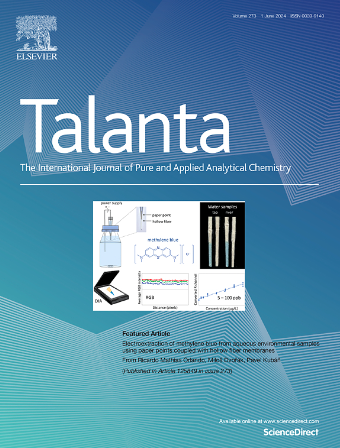Voltammetric determination of lercanidipine in urine, blood plasma, and serum using hollow fiber-based liquid phase microextraction
IF 5.6
1区 化学
Q1 CHEMISTRY, ANALYTICAL
引用次数: 0
Abstract
This study investigates a synergistic combination of hollow fiber-based liquid phase microextraction (HF-LPME) and voltammetric analysis using screen-printed boron-doped diamond electrodes (SP-BDDE) for the determination of antihypertensive drug lercanidipine (LCN) in urine, blood plasma, and blood serum. Optimum HF-LPME conditions were: dodecane as supported liquid membrane, Britton-Robinson buffer (BRB) pH 7 as donor solution, BRB pH 3 as acceptor solution, and extraction time 30 min. Square-wave voltammetry (SWV) of 10 μL acceptor solution at SP-BDDE was utilized with amplitude 75 mV, frequency 10 Hz, and potential step 4 mV. The calibration dependence of the combined HF-LPME-SWV method was established in the range of 1–1000 nmol L−1, with limits of quantification (LOQ) and detection (LOD) of 3.3 and 1.1 nmol L−1, respectively. The applicability of the developed method was verified by analysis of human urine, blood plasma, and blood serum samples spiked with 20 and 100 nmol L−1 LCN with recoveries ranging from 93.2 to 112.9 % with respective RSDs 1.72–8.5 % (n = 3).

求助全文
约1分钟内获得全文
求助全文
来源期刊

Talanta
化学-分析化学
CiteScore
12.30
自引率
4.90%
发文量
861
审稿时长
29 days
期刊介绍:
Talanta provides a forum for the publication of original research papers, short communications, and critical reviews in all branches of pure and applied analytical chemistry. Papers are evaluated based on established guidelines, including the fundamental nature of the study, scientific novelty, substantial improvement or advantage over existing technology or methods, and demonstrated analytical applicability. Original research papers on fundamental studies, and on novel sensor and instrumentation developments, are encouraged. Novel or improved applications in areas such as clinical and biological chemistry, environmental analysis, geochemistry, materials science and engineering, and analytical platforms for omics development are welcome.
Analytical performance of methods should be determined, including interference and matrix effects, and methods should be validated by comparison with a standard method, or analysis of a certified reference material. Simple spiking recoveries may not be sufficient. The developed method should especially comprise information on selectivity, sensitivity, detection limits, accuracy, and reliability. However, applying official validation or robustness studies to a routine method or technique does not necessarily constitute novelty. Proper statistical treatment of the data should be provided. Relevant literature should be cited, including related publications by the authors, and authors should discuss how their proposed methodology compares with previously reported methods.
 求助内容:
求助内容: 应助结果提醒方式:
应助结果提醒方式:


